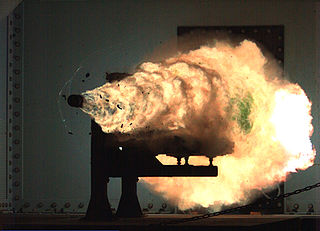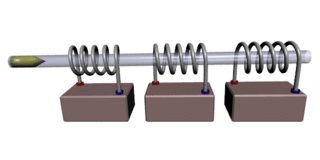Related Research Articles
Electrothermal-chemical (ETC) technology is an attempt to increase accuracy and muzzle energy of future tank, artillery, and close-in weapon system guns by improving the predictability and rate of expansion of propellants inside the barrel.

A mass driver or electromagnetic catapult is a proposed method of non-rocket spacelaunch which would use a linear motor to accelerate and catapult payloads up to high speeds. Existing and proposed mass drivers use coils of wire energized by electricity to make electromagnets, though a rotary mass driver has also been proposed. Sequential firing of a row of electromagnets accelerates the payload along a path. After leaving the path, the payload continues to move due to momentum.

A linear motor is an electric motor that has had its stator and rotor "unrolled", thus, instead of producing a torque (rotation), it produces a linear force along its length. However, linear motors are not necessarily straight. Characteristically, a linear motor's active section has ends, whereas more conventional motors are arranged as a continuous loop.

An electric motor is an electrical machine that converts electrical energy into mechanical energy. Most electric motors operate through the interaction between the motor's magnetic field and electric current in a wire winding to generate force in the form of torque applied on the motor's shaft. An electric generator is mechanically identical to an electric motor, but operates in reverse, converting mechanical energy into electrical energy.

A railgun or rail gun is a linear motor device, typically designed as a weapon, that uses electromagnetic force to launch high-velocity projectiles. The projectile normally does not contain explosives, instead relying on the projectile's high kinetic energy to inflict damage. The railgun uses a pair of parallel conductors (rails), along which a sliding armature is accelerated by the electromagnetic effects of a current that flows down one rail, into the armature and then back along the other rail. It is based on principles similar to those of the homopolar motor.

A coilgun is a type of mass driver consisting of one or more coils used as electromagnets in the configuration of a linear motor that accelerate a ferromagnetic or conducting projectile to high velocity. In almost all coilgun configurations, the coils and the gun barrel are arranged on a common axis. A coilgun is not a rifle as the barrel is smoothbore.
Muzzle velocity is the speed of a projectile with respect to the muzzle at the moment it leaves the end of a gun's barrel. Firearm muzzle velocities range from approximately 120 m/s (390 ft/s) to 370 m/s (1,200 ft/s) in black powder muskets, to more than 1,200 m/s (3,900 ft/s) in modern rifles with high-velocity cartridges such as the .220 Swift and .204 Ruger, all the way to 1,700 m/s (5,600 ft/s) for tank guns firing kinetic energy penetrator ammunition. To simulate orbital debris impacts on spacecraft, NASA launches projectiles through light-gas guns at speeds up to 8,500 m/s (28,000 ft/s). FPS and MPH are the most common American measurements for bullets. Several factors, including the type of firearm, the cartridge, and the barrel length, determine the bullet's muzzle velocity.
A magnetic weapon is one that uses magnetic fields to accelerate or stop projectiles, or to focus charged particle beams. There are many hypothesized magnetic weapons, such as the railgun and coilgun which accelerate a magnetic mass to a high velocity, or ion cannons and plasma cannons which focus and direct charged particles using magnetic fields.
Magnetic gun may refer to:
Henry Herbert Kolm was an American physicist associated with Massachusetts Institute of Technology (MIT) for many years, with extensive expertise in high-power magnets and strong magnetic fields.
Constructed in 1976 and 1977, Mass Driver 1 was an early demonstration of the concept of the mass driver, a form of electromagnetic launcher, which in principle could also be configured as a rocket motor, using asteroidal materials for reaction mass and energized by solar or other electric power.
Plasma cannon may refer to:
A brushed DC electric motor is an internally commutated electric motor designed to be run from a direct current power source and utilizing an electric brush for contact.

The Electro-Magnetic Laboratory Rail Gun is a 32-megajoule electro-magnetic laboratory rail gun being evaluated by the US Office of Naval Research (ONR) Naval Air Warfare and Weapons Department. The US Navy is pursuing development of the launcher system through two industry teams – General Atomics and BAE Systems – to reduce risk in the program and to foster innovation in next-generation shipboard weapons. The same amount of energy is released by the detonation of 4.8 kg (11 lb) of C4.

An electromagnetic lock, magnetic lock, or maglock is a locking device that consists of an electromagnet and an armature plate.
A ram accelerator is a device for accelerating projectiles or just a single projectile to extremely high speeds using jet-engine-like propulsion cycles based on ramjet or scramjet combustion processes. It is thought to be possible to achieve non-rocket spacelaunch with this technology.
A plasma railgun is a linear accelerator which, like a projectile railgun, uses two long parallel electrodes to accelerate a "sliding short" armature. However, in a plasma railgun, the armature and ejected projectile consists of plasma, or hot, ionized, gas-like particles, instead of a solid slug of material. Scientific plasma railguns are typically operated in vacuum and not at air pressure. They are of value because they produce muzzle velocities of up to several hundreds of kilometers per second. Because of this, these devices have applications in magnetic confinement fusion (MCF), magneto-inertial fusion (MIF), high energy density physics research (HEDP), laboratory astrophysics, and as a plasma propulsion engine for spacecraft.
The Cannon-Caliber Electromagnetic Gun (CCEMG) launcher is a rapid-fire railgun launcher developed by the U.S. military in the early 1990s to study and test the viability of electromagnetic weapons.
In engineering, a solenoid is a device that converts electrical energy to mechanical energy, using an electromagnet formed from a coil of wire. The device creates a magnetic field from electric current, and uses the magnetic field to create linear motion.

The E-Shotgun, also referred to as the E-Gun, Northshore Sports Club CA-09, or the PD-90 Advanced Coilgun, is a hand-held automatic 9-stage coilgun designed by Lei Fengqiao and manufactured by China North Industries Group Corp in Xicheng District, Beijing, China. In 2023, the CS/LW21 was commissioned by the Chinese government in order to "Quell Violent Protests".
References
- ↑ Baum, Carl E. (26 December 2007). "Some Electromagnetic Considerations for Design of Railgun Electromagnetic Projectile Launchers" (PDF). UNM Electrical and Computer Engineering. Archived (PDF) from the original on 19 April 2017. Retrieved 17 November 2022.
- ↑ Kolm, H.; et al. (1980). "Electromagnetic Guns, Launchers, and Reaction Engines". 2nd International Pulsed Power Conference. Massachusetts Institute of Technology: 42. Bibcode:1979pupo.conf...42K.
- 1 2 Engel, T.G. (17–22 June 2007). "Solid-Projectile Helical Coil Electromagnetic Launcher" (PDF). 2007 IEEE 34th International Conference on Plasma Science (ICOPS). pp. 1789–1792. doi:10.1109/PPPS.2007.4346319. ISBN 978-1-4244-0915-0. S2CID 12419490 . Retrieved 18 January 2024.